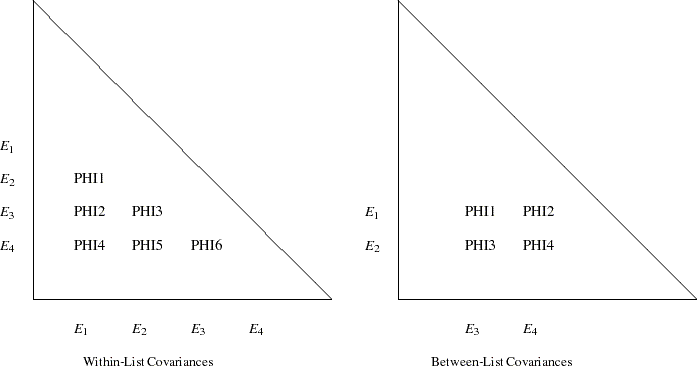| The CALIS Procedure |
| COV Statement |
- COV assignment <, assignment ...> ;
 variables2 >> = pattern-definition
variables2 >> = pattern-definition The COV statement tells which covariances are parameters to estimate and which are fixed. The COV statement can be used only with the LINEQS statement. The COV statement differs from the STD statement only in the meaning of the left-hand-side variables list. You can specify only one COV statement with each LINEQS statement. The COV statement defines the off-diagonal elements of the central model matrix  . These elements correspond to the covariances of the exogenous variables and to the error covariances of the endogenous variables. Elements that are not defined are assumed to be zero. The assignments in the COV statement must be separated by commas.
. These elements correspond to the covariances of the exogenous variables and to the error covariances of the endogenous variables. Elements that are not defined are assumed to be zero. The assignments in the COV statement must be separated by commas.
The variables list on the left-hand side of the equal sign should contain only names of variables that do not appear on the left-hand side of an equation in the LINEQS statement—that is, exogenous, error, and disturbance variables.
The pattern-definition on the right-hand side is similar to that used in the MATRIX statement. Each list element on the right-hand side defines the covariance of a pair of variables in the list on the left-hand side. A name on the right-hand side can be followed by a number inside parentheses that gives the initial value. A number on the right-hand side means that the corresponding covariance of the variable on the left-hand side is fixed. If the right-hand-side list is longer than the left-hand-side variable list, the right-hand-side list is shortened to the length of the variable list. If the right-hand-side list is shorter than the variable list, the right-hand-side list is filled with repetitions of the last item in the list.
You can use one of two alternatives to refer to parts of  . The first alternative uses only one variable list and refers to all distinct pairs of variables within the list. The second alternative uses two variable lists separated by an asterisk and refers to all pairs of variables among the two lists.
. The first alternative uses only one variable list and refers to all distinct pairs of variables within the list. The second alternative uses two variable lists separated by an asterisk and refers to all pairs of variables among the two lists.
Within-List Covariances
Using k variable names in the variables list on the left-hand side of an equal sign in a COV statement means that the parameter list (pattern-definition) on the right-hand side refers to all  distinct variable pairs in the below-diagonal part of the
distinct variable pairs in the below-diagonal part of the  matrix. Order is very important. The order relation between the left-hand-side variable pairs and the right-hand-side parameter list is illustrated by the following example:
matrix. Order is very important. The order relation between the left-hand-side variable pairs and the right-hand-side parameter list is illustrated by the following example:
COV E1-E4 = PHI1-PHI6 ;
This is equivalent to the following specification:
COV E2 E1 = PHI1,
E3 E1 = PHI2, E3 E2 = PHI3,
E4 E1 = PHI4, E4 E2 = PHI5, E4 E3 = PHI6;
The symmetric elements are generated automatically. When you use prefix names on the right-hand sides, you do not have to count the exact number of parameters. For example,
COV E1-E4 = PHI: ;
generates the same list of parameter names if the prefix PHI is not used in a previous statement. This is illustrated in the left panel of Figure 25.2. Integers starting from 1 are appended to the prefix PHI to form the parameter names for each of the within-list covariances.

Between-List Covariances
Using  and
and  variable names in the two lists (separated by an asterisk) on the left-hand side of an equal sign in a COV statement means that the parameter list on the right-hand side refers to all
variable names in the two lists (separated by an asterisk) on the left-hand side of an equal sign in a COV statement means that the parameter list on the right-hand side refers to all  distinct variable pairs in the
distinct variable pairs in the  matrix. Order is very important. The order relation between the left-hand-side variable pairs and the right-hand-side parameter list is illustrated by the following example:
matrix. Order is very important. The order relation between the left-hand-side variable pairs and the right-hand-side parameter list is illustrated by the following example:
COV E1 E2 * E3 E4 = PHI1-PHI4 ;
This is equivalent to the following specification:
COV E1 E3 = PHI1, E1 E4 = PHI2,
E2 E3 = PHI3, E2 E4 = PHI4;
The symmetric elements are generated automatically. Using prefix names on the right-hand sides lets you achieve the same purpose without counting the number of parameters. That is,
COV E1 E2 * E3 E4 = PHI: ;
This is illustrated in the right panel of Figure 25.2. Integers starting from 1 are appended to the prefix PHI to form the parameter names for each of the between-list covariances.
Copyright © 2009 by SAS Institute Inc., Cary, NC, USA. All rights reserved.